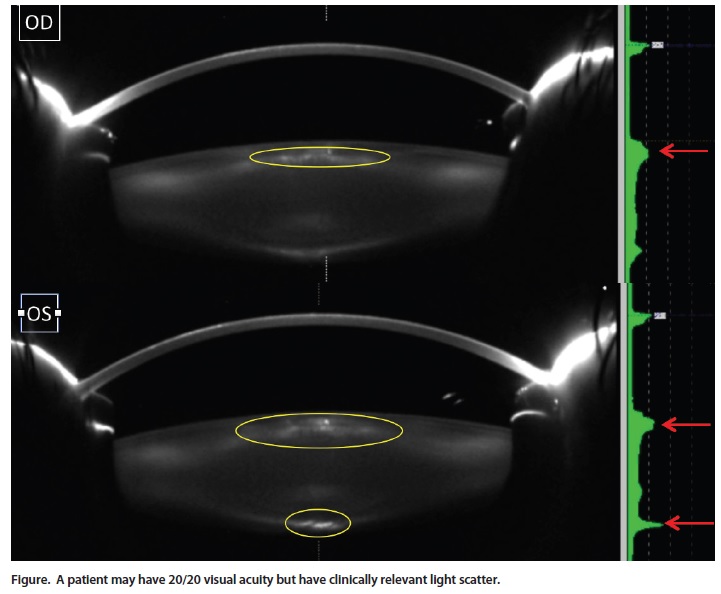Welcome to another edition of “Ophthalmology 360.” This monthly column is put together by the members of CEDARS (Cornea, External Disease, and Refractive Surgery Society), ASPENS (American Society of Progressive Enterprising Surgeons), and Vanguard Ophthalmology. This month, Vanguard and CEDARS member George O. Waring IV, MD, describes dysfunctional lens syndrome. This entity is now gaining more attention and may become a major component of ophthalmology practices as the baby boomer population ages. We hope you enjoy this discussion.
—Kenneth A. Beckman, MD, section editor
Patients in their mid-50s to 60s often present for a LASIK evaluation because they no longer want to use glasses for both distance and reading. These baby boomer patients have difficulty seeing at distance, due to congenital ametropia, and at near, due to their progressive presbyopia. They do not come in stating that they cannot drive at night due to glare; instead, they are seeking an elective procedure to provide spectacle independence. For many years, we performed LASIK on these types of patients. However, they would frequently come back complaining that their LASIK had “worn off.”
In my practice, we began paying attention to the source of the issue for these patients: the aging of the crystalline lens. Using an advanced ocular analysis and including a digital “lens-centric” examination, we often find that baby boomer patients presenting for LASIK do not have clear lenses; instead, they have dysfunctional lens syndrome (DLS), a clinical entity that has been overlooked and inadequately characterized for years. DLS describes a constellation of ways that the crystalline lens progressively becomes dysfunctional due to aging, including opacification and loss of accommodation. Additionally, higher-order aberrations increase in the aging lens, and exacerbation of narrow angles may also occur.

The term dysfunctional lens syndrome characterizes the dysfunctionality of the lens as a spectrum of changes that occur ubiquitously with age. Part of the rationale behind the terminology is to avoid the use of the terms very early cataract or precataract. These terms are dismissive and imply that the patient's only option is to wait for that very early cataract to ripen or for that precataract to become a cataract, delaying surgery by 5 to 10 years or longer.
Dysfunctional lens replacement for DLS is becoming increasingly popular in our practice, and patients respond well to this treatment option because we educate them appropriately. Combining the use of dilated Scheimpflug imaging and associated densitometry with the AcuTarget HD (AcuFocus) double-pass wavefront diagnostic device, we take patients on a digital tour of their eyes, showing them their dysfunctional lens and the resulting light scatter. The AcuTarget HD generates an ocular scatter index, which gives patients a score for their quality of vision. A patient may have 20/20 visual acuity but have clinically relevant light scatter (Figure). Showing patients the light scatter (point spread function) and increased ocular scatter index helps them to understand the value of addressing the source of the problem, the aging crystalline lens, and addressing it with a single procedure while preventing future formation of cataracts.
During the refractive consultation, we emphasize to all patients that DLS is a normal part of the aging process and that no action is required. For patients who wish to pursue surgery to treat presbyopia, dysfunctional lens replacement is presented as an option. As with all surgical procedures, we outline the relative risks and benefits of each technique. We are careful to point out that lens surgery is more invasive than LASIK, as the former is an intraocular procedure and thus carries increased surgical risks.
CONCLUSION
In my community, patients are hearing about this treatment and seeking it out. Of course, when patients present with a clear lens, unless they are high hyperopes, I advise them that they may be better candidates for a corneabased procedure. The paradigm is certainly changing. Dysfunctional lens replacement is an all-in-one solution, and this procedure may end up being considered LASIK for the baby boomers. n
Section Editor Kenneth A. Beckman, MD
• director of corneal services at Comprehensive EyeCare of Central Ohio in Westerville, Ohio
• clinical assistant professor of ophthalmology at The Ohio State University in Columbus and president of CEDARS
• (614) 890-5692; kenbeckman22@aol.com; Twitter: @KenBeckmanMD
George O. Waring IV, MD
• director of refractive surgery and an assistant professor of ophthalmology at the Storm Eye Institute, Medical University of South Carolina
• medical director of the Magill Vision Center in Mt. Pleasant, South Carolina.
• waringg@musc.edu; Twitter: @georgewaring
• financial disclosure: consultant to Acufocus


